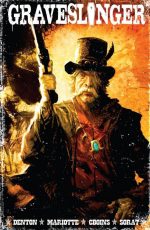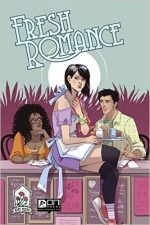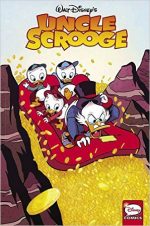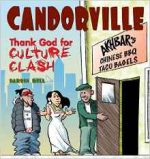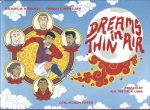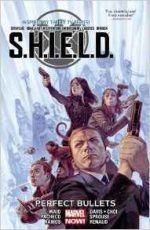
By Mark Waid, Carlo Pacheco, Humberto Ramos, Alan Davis, Chris Sprouse, Mike Choi, Chris Renaud & various (Marvel)
ISBN: 978-0-7851-9362-3
Just as the 1960s espionage fad was taking off, inspired by the James Bond films and TV shows like Danger Man, war hero Nick Fury “re-debuted†in Fantastic Four #21 as a spy.
That was December 1963 – between issues #4 and 5 of his own blistering battle mag – and the perpetually grizzled warrior was re-imagined as a cunning CIA Colonel lurking at the periphery of big adventures, craftily manipulating the First Family of Marvel superheroes into taking on a racist demagogue with a world-shattering secret…
Fury was already the star of the little company’s only war comic: Sgt. Fury and his Howling Commandos, an improbable and decidedly over-the-top, wild WWII-set series similar in tone to later movies such as The Magnificent Seven, Wild Bunch and The Dirty Dozen.
When spy stories went global in the wake of The Man from U.N.C.L.E., the veteran’s elder iteration was given a second series (from Strange Tales #135, August 1965), set in the then-present. Nick Fury, Agent of S.H.I.E.L.D. combined Cold War tensions and sinister schemes of World Conquest by hidden, subversive all-encompassing enemy organisation Hydra – all gift-wrapped with captivating Kirby-designed super-science gadgets and explosive high energy. It was set firmly in the heart of the slowly burgeoning Marvel Universe…
Once iconic imagineer Jim Steranko took charge, layering in a sleek, ultra-sophisticated edge of trend-setting drama, the series became one of the best and most visually innovative strips in America, if not the world.
When the writer/artist left and the spy-fad faded, the whole concept simply withdrew into the background architecture of the Marvel Universe, occasionally resurfacing in new series but growing increasingly uncomfortable to read as the role of spooks “on our side†became ever more debased in a world where covert agencies were continually exposed as manipulative, out-of-control tools of subversion and oppression.
In 1989 a six issue prestige format miniseries reinvigorated the concept. As a company targeting the youth-oriented markets, Marvel had experienced problems with their in-house clandestine organisation. In almost all of their other titles, US agents and “the Feds†were usually the bad guys. Author Bob Harras used this theme as well as the oddly quirky self-referential fact that nobody aged in comic continuity to play games with the readers…
Fury had discovered that everybody in his organisation had been “turned†and was now an actual threat to freedom and democracy. With his core beliefs and principles about leading “the Good Guys†betrayed and destroyed, he went on the run, hunted by the world’s most powerful covert agency with all the resources he’d devised and utilised now turned against him.
As part of the resolution SHIELD was reinvented for the 1990s: a leaner, cleaner, organisation, nominally acting under UN mandate, and proactive throughout the Marvel Universe. The taste of betrayal and seeds of doubt and mistrust never went away though…
Following numerous global crises – including a superhero Civil War – Fury was replaced as SHIELD director. His successor Tony Stark proved to be a huge mistake and after an alien invasion by Skrulls, the organisation was mothballed: replaced by the manically dynamic Norman Osborn and his fanatically loyal H.A.M.M.E.R. project. As America’s top Fed, he was specifically tasked with curbing the unchecked power and threat of the burgeoning metahuman community.
Osborn’s ascent was an even bigger error. As America’s Director of National Security the former Green Goblin and not-really-recovering psychopath instituted a draconian “Dark Reign†of oppressive, aggressive policies which turned the nation into a paranoid tinderbox.
This spectacularly poor choice was, however, also directing a cabal of the world’s greatest criminals and conquerors intent on divvying up the planet between them. The repercussions of Osborn’s rise and fall were felt throughout and featured in many series and collections throughout the entire fictive continuity. His brief rule also drastically shook up the entrenched secret powers of the planet and his ultimate defeat destabilised many previously unassailable empires…
Fury, a man driven by duty, fuelled by suspicion and powered by a serum which kept him vital far beyond his years, didn’t go away. He just went deep undercover and continued doing what he’d always done: saving the world, one battle at a time. Even after Osborn was gone, Fury stayed buried, preferring to fight battles his way and with assets and resources he’d personally acquired and built…
Since the concept became an integral part of Marvel’s cinematic and TV universe, the comics division has laboured to find a way to rationalise their two wildly dissimilar iterations of SHIELD. In 2015 scripter Mark Waid and a rotating squad of illustrators finally settled on a way to square that circle…
S.H.I.E.L.D. – now standing for the Strategic Homeland Intervention Enforcement Logistics Division – is still a major player in defending humanity from the unimaginable, but movie icon Phil Coulson, his core TV team of Melinda May, Leo Fitz and Jemma Simmons, plus hybrid versions of print-turned-screen stars such as Bobbi (Mockingbird) Morse have been deftly hived off into their own niche of comicbook continuity with Coulson in charge of an official sub-agency where – supplemented by SHIELD resources – his own geekishly vast and deep knowledge of metahuman trivia and contacts with the entire super-heroic community combine to tackle unnatural crises on a case-by-case basis…
The result – written by the master planner Mark Waid and illustrated by a rotating roster of star artists – is a fresh and supremely appetising blend of spies, sinister secret villains and super folk that is a joy to behold…
Collecting issues #1-6 of the breakthrough series (technically S.H.I.E.L.D. volume 3, spanning February to July 2015, if you’re keeping count) this volume commences with the eponymous ‘Perfect Bullets’ (illustrated by Carlos Pacheco, Mariano Taibo & Jason Paz, with Dono Sanchez Almara providing the colours) as SHIELD Special Ops Supreme Commander Coulson is forced to rally his barely wet-behind-the-ears unit to tackle a middle-eastern terrorist who has somehow latched onto a magic sword allowing him to summon all the monsters of mythology to batter the Earth.
As all the planet’s heroes wage a losing war against the invasion of gargantuan terrors, Coulson’s team rapidly identify the true owner of the blade and deploy the two ideal superheroes able to counter its threat…
Sadly, however, when the sword is restored to its rightful wielder, a hidden extra-dimensional presence is unleashed, forcing Coulson to improvise a final solution…
Then, adding funny to the fast and furious, a brace of comedic shorts follows. Crafted by Joe Quesada and starring boy-genius Fitz and his digital avatar H.E.N.R.Y., these strips were originally concocted to amuse the cast and crew of the TV show…
The all-comics action resumes with ‘The Animator’ (art by Humberto Ramos, Victor Olazabo & Edgar Delgado) as Xenobiology specialist Simmons is sent undercover to a High School in Jersey City to crack a smuggling ring. Of course, being a SHIELD Special Ops mission, the contraband being sought is not drugs of guns or something equally mundane, but rather weapons and tech stolen from super-villains.
Things instantly go bad when a Wizard power-glove stashed in a locker spontaneously activates, causing a riot. Thankfully fresh new Ms. Marvel Kamala Khan is a student at the beleaguered institution and steps up, impressing Coulson in the process…
Sadly it’s not the only crisis on campus as bio-plasm from genetic meddler Arnim Zola infects the cafeteria food, turning hungry kids into ravenous monsters…
With that catastrophe stomach-churningly averted, Fitz and H.E.N.R.Y. make another mirthful appearance before Alan Davis, Mark Farmer and colourist Matthew Wilson make the pictures for ‘Home Invasion’ as Coulson, Spider-Man and mystic parolee Mr. Rasputin break into the bewitched citadel of Doctor Strange to battle mystic mercenaries hired to raid the storehouse of magical wonders.
The thieves think they had it covered but their meddling unleashes forces that imperil the entire Earth. Moreover, in the aftermath Coulson sees something which sets him thinking that one hand might be behind the many threats his team has recently tackled…
After another delightful Fitz and H.E.N.R.Y. escapade, Chris Sprouse, Carl Story & Almara illustrate a deeply disturbing tale as Invisible Woman Susan Richards is seconded to the Special Ops unit to save a reluctant Hydra informant from a radioactive prison five miles underground. Sadly as ‘Fuel’ unfolds she discovers the truly vicious duplicity of her opponents and endures cruel whims of fate as the Mole Man attacks everybody and Coulson is forced to intervene before atomic Armageddon ensues…
The fifth instalment starts drawing disparate plot points together as the world’s mystics and supernatural champions are systematically gunned down by an assassin firing purpose-built ‘Magic Bullets’ (with art by Mike Choi and colourist Rachelle Rosenberg)…
With his resources reduced to the Scarlet Witch and professional sceptics Fitz and Simmons, Coulson uncovers a connection to Asgard and a mystery magical mastermind, only to have his team supernaturally suborned as the hidden manipulator makes his long-anticipated move…
This immensely entertaining epic concludes as Earth is afflicted with an arcane plague transforming humanity into mindless monsters compelling Coulson to assemble a squad of intellect-deficient atrocities – zombie Simon Garth, the Living Mummy, Frankenstein’s Monster and Man-Thing – into an all-new unit of Howling Commandos to invade the ‘Dark Dimensions’ (illustrated by Paul Renaud & Romulo Farjado, Jr.) and stop the contagion and its creator at the source.
And because he’s the sneaky bastard he is, Coulson also takes along a secret weapon: the last villain anyone might expect to save the universe…
Fast-paced, action-packed, imaginative, thrilling, funny and superbly illuminated throughout, Perfect Bullets offers fantastic enjoyment for any Fights ‘n’ Tights fan with a smattering of Marvel history in their heads, but will particularly reward any TV aficionado willing to peek into the convoluted comicbook universe the SHIELD show sprang from.
© 2015 Marvel Characters. All rights reserved.



